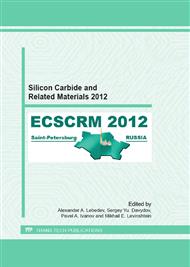p.589
p.593
p.597
p.601
p.605
p.609
p.613
p.617
p.621
Dielectric Properties of Thermally Grown SiO2 on 4H-SiC(0001) Substrates
Abstract:
The bulk properties of thermally grown SiO2 on 4H-SiC(0001) substrates were thoroughly investigated by capacitance-voltage (C-V) measurement, atomic force microscopy (AFM), spectroscopic ellipsometry (SE), x-ray photoelectron spectroscopy (XPS), and secondary ion mass spectrometry (SIMS). The equivalent oxide thickness (EOT) extracted from the capacitance-voltage (C-V) characteristics of TiN/SiO2 capacitors was proportional to the physical thickness (Tphys), but the slope of the linear fit was found to be 1.11, indicating that the permittivity of SiO2 on 4H-SiC formed by thermal oxidation is only about 3.5, which is lower than the commonly accepted value of 3.9. Since XPS analysis revealed that the oxide of SiC was stoichiometric and the atomic concentration of residual carbons in the oxide measured by SIMS was sufficiently low (1017 cm-3), the low permittivity of thermal oxides of 4H-SiC may originate from the reduced bulk density, which can be predicted by the Clausius-Mossotti relation.
Info:
Periodical:
Pages:
605-608
Citation:
Online since:
January 2013
Keywords:
Price:
Сopyright:
© 2013 Trans Tech Publications Ltd. All Rights Reserved
Share:
Citation:


